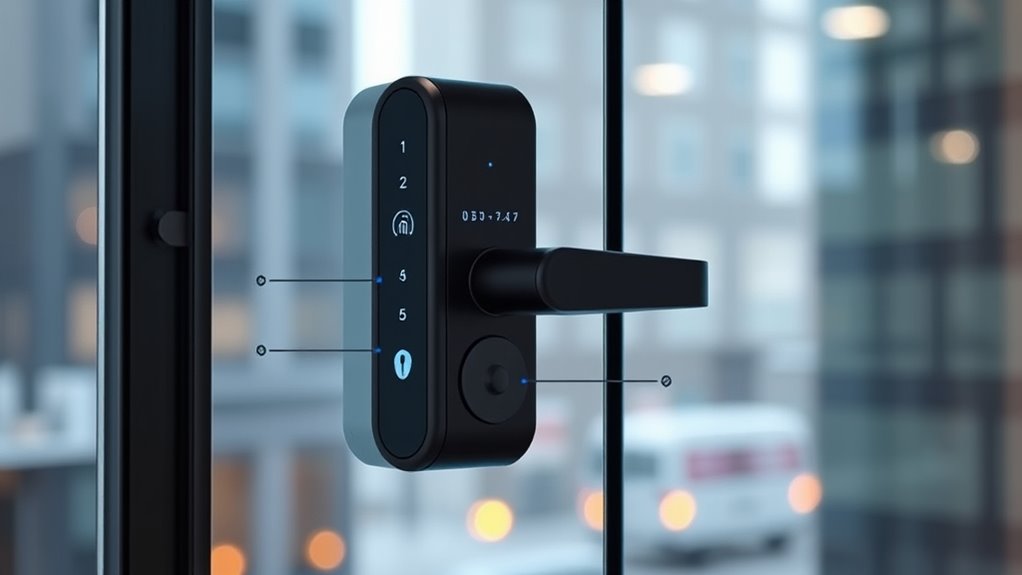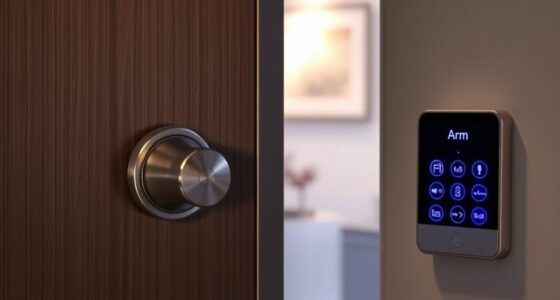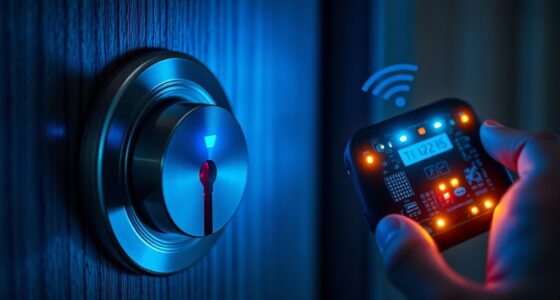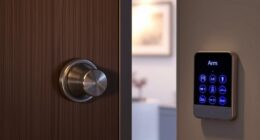To future-proof your smart lock, choose one with modular hardware that allows you to upgrade components like connectivity, security features, and aesthetics over time. This flexibility helps your lock adapt to new technologies and personal preferences, reducing the need for complete replacements. By selecting a system designed for easy upgrades and customization, you can guarantee durability and long-term relevance. Keep exploring how modular design can keep your smart lock prepared for years ahead.
Key Takeaways
- Incorporate interchangeable modules for easy upgrades in security features, connectivity, and aesthetics.
- Use modular designs compatible with future protocols like Bluetooth, Wi-Fi, Zigbee, and Z-Wave.
- Prioritize battery efficiency and easy maintenance to ensure long-term reliability and minimal downtime.
- Implement adaptable hardware that supports biometric integration and other emerging security innovations.
- Follow best practices for seamless aesthetic integration and regional compatibility to future-proof design.
Understanding the Need for Flexibility in Smart Lock Design
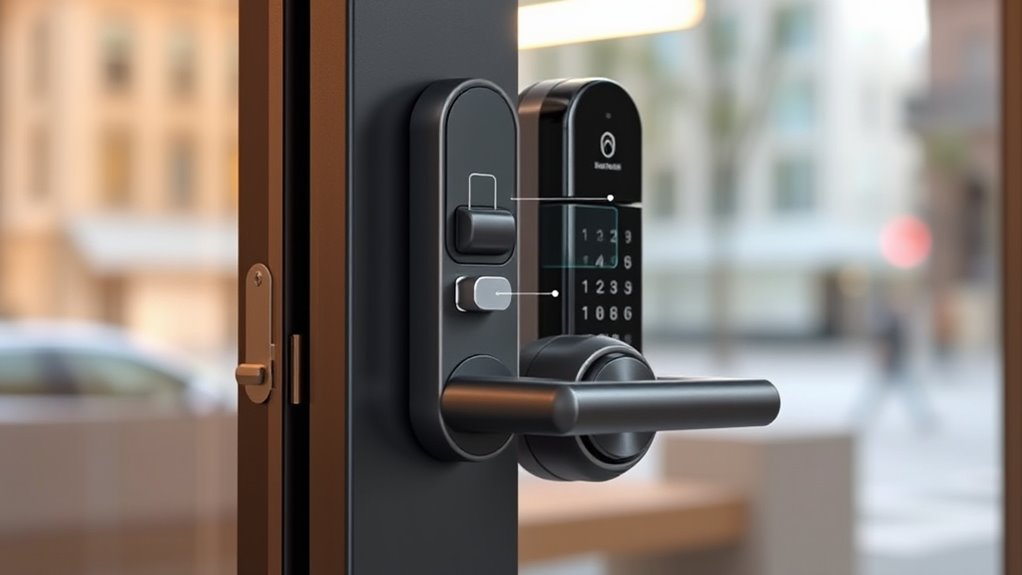
As smart lock technology evolves, flexibility in design becomes essential to meet diverse user needs and future advancements. You want a lock that can seamlessly adapt to new features like biometric integration, which enhances security and convenience. Customization options also matter, allowing you to match your lock with your home’s aesthetic and personal style. Flexible designs ensure your smart lock remains relevant as technology progresses, reducing the need for frequent replacements. By prioritizing adaptable hardware, you can easily upgrade or add new functionalities without overhauling the entire system. This approach offers long-term value, making your smart lock more than just a security device—it becomes a versatile, personalized part of your smart home. Flexibility in design ultimately keeps you future-ready. Incorporating modular hardware makes it easier to implement these upgrades and maintain compatibility with emerging technologies.
Key Components of Modular Hardware in Smart Locks
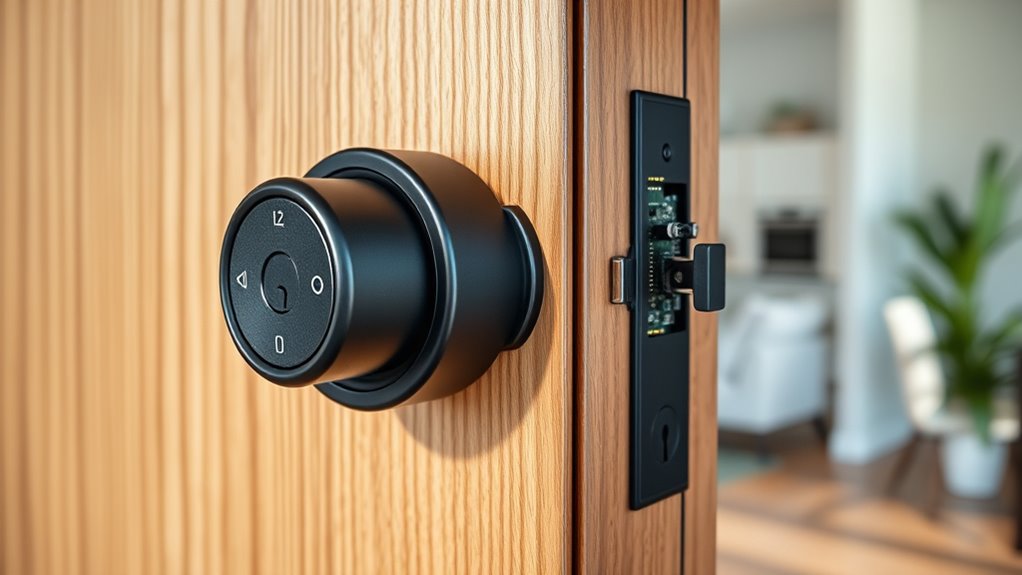
Modular hardware in smart locks relies on interchangeable lock modules, allowing you to customize and upgrade components without replacing the entire device. Upgradable connectivity options guarantee your lock stays compatible with new technologies as they emerge. Focusing on these key components helps you future-proof your smart lock investment. Incorporating elements like juice cleansing can enhance your understanding of health trends that may influence user preferences and product features.
Interchangeable Lock Modules
Interchangeable lock modules serve as the key to flexibility in smart lock design, allowing you to upgrade or customize your lock system without replacing the entire device. These modules enable quick swaps, making maintenance and upgrades straightforward. When considering lock modules, focus on:
- Battery lifespan – choose modules that optimize power efficiency for longer use.
- Installation procedures – look for designs that simplify setup, reducing time and effort.
- Compatibility – ensure modules fit your existing lock system without extensive modifications.
- Security features – pick modules with advanced encryption or tamper alerts for added protection.
Additionally, modular hardware promotes a sustainable approach by minimizing waste and extending the lifespan of your smart lock system.
This modularity means you can adapt your lock over time as technology advances or your security needs change, all while maintaining easy installation and reliable performance.
Upgradable Connectivity Options
Upgradable connectivity options form the backbone of adaptable smart lock systems, allowing you to enhance or modify how your lock communicates with other devices over time. By choosing modular hardware with support for various wireless protocols, you guarantee your lock stays compatible with future smart home technologies. These options enable seamless integration with Bluetooth, Wi-Fi, Zigbee, or Z-Wave, depending on your needs. Good power management is essential, as it preserves battery life even when upgrading connectivity modules. Future-proofing means you won’t need to replace your entire lock if new protocols emerge or existing ones evolve. Instead, you can simply upgrade the connectivity module, keeping your smart lock current and functional without extra hassle or cost. Material compatibility also plays a role in ensuring that new modules fit seamlessly with existing hardware and maintain overall system integrity.
Benefits of Upgradable and Customizable Lock Systems
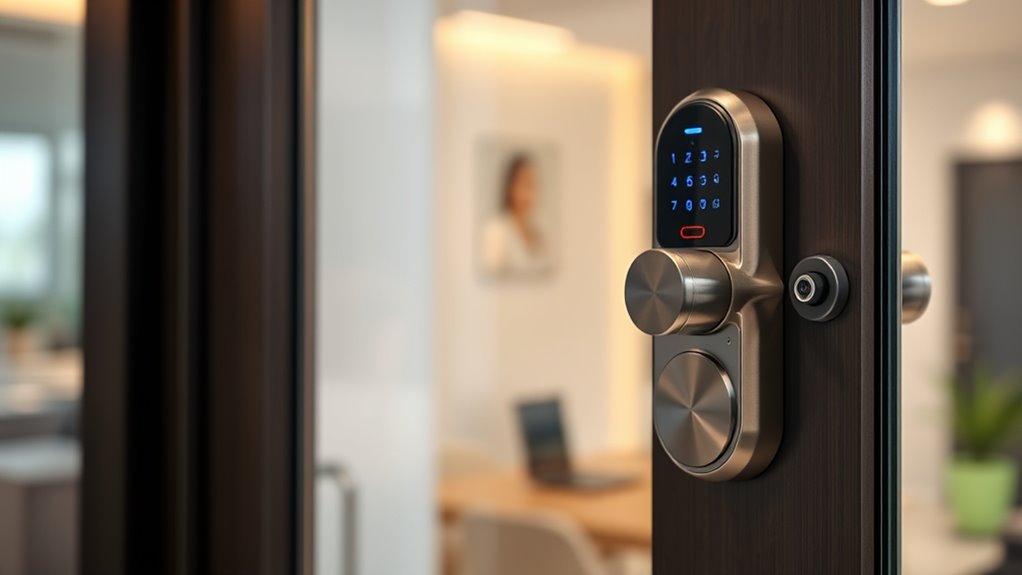
Upgradable and customizable lock systems offer you long-term versatility, allowing your lock to adapt to changing needs over time. With personalized security features, you can tailor your lock’s functionality to fit your specific preferences. This flexibility guarantees your smart lock remains effective and relevant for years to come. Additionally, considering the trustworthiness of the brand, ensures that your investment is protected and reliable.
Long-Term Versatility
As technology evolves, choosing a smart lock with long-term versatility guarantees your system stays current and secure. Modular hardware allows you to adapt easily, saving you time and money. Consider these benefits:
- Extended battery longevity, reducing maintenance and ensuring reliable access.
- Aesthetic customization options, so your lock matches your style and home decor.
- Future upgrades that keep your lock compatible with new smart home integrations.
- Hardware flexibility, enabling you to add features or replace components without full replacement.
- Incorporating vertical storage solutions can help organize and maintain your smart lock components and accessories, ensuring easy access and preventing clutter.
This adaptability means your smart lock remains functional and stylish over time, even as technology advances. You avoid obsolescence while maintaining security and convenience. Long-term versatility makes your investment truly future-proof.
Personalized Security Features
Because technology and security threats are constantly evolving, having a smart lock that offers personalized security features allows you to tailor your system to your specific needs. With biometric access, you can enhance security by using fingerprints or facial recognition, ensuring only authorized individuals gain entry. Upgradable locks also let you add or refine features like emergency overrides, giving you peace of mind during urgent situations. Customizing your lock system means you can select the security layers that matter most, whether it’s multi-factor authentication or remote access controls. This flexibility ensures your smart lock remains effective against new threats and adapts to your lifestyle. Incorporating sound healing science principles into your security system design can also help reduce stress and improve overall confidence in your setup. Personalization isn’t just about convenience—it’s about creating a security solution that truly fits you.
Selecting Compatible Modules for Future Expansion
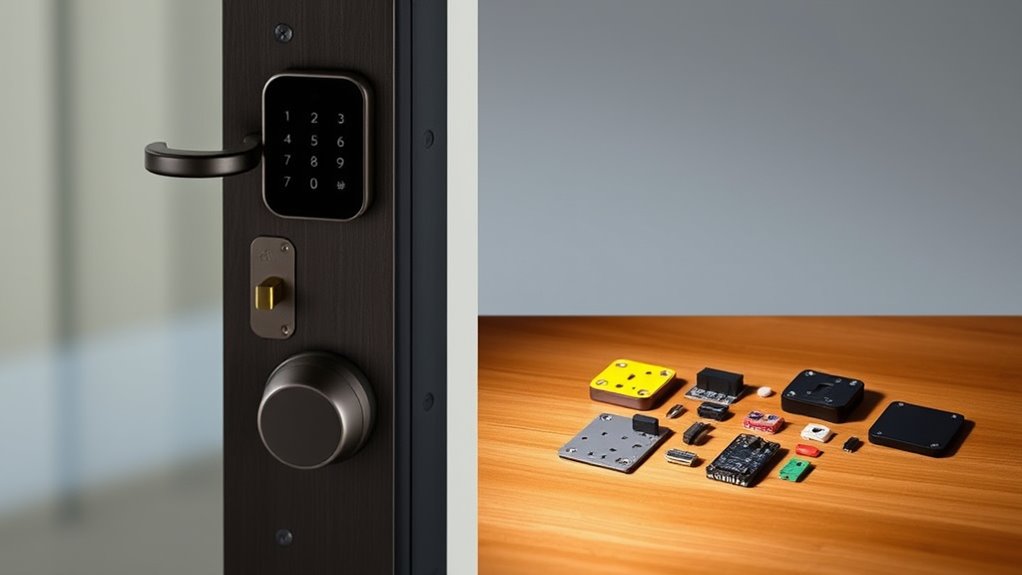
Choosing compatible modules for future expansion is essential to guarantee your smart lock system remains flexible and adaptable over time. To confirm seamless upgrades, consider these factors:
Prioritize compatible modules to ensure your smart lock system’s flexibility and easy future upgrades.
- Verify biometric integration options to support advanced authentication methods.
- Ensure power management modules are compatible to maintain battery efficiency and backup features.
- Check connection standards, like Bluetooth or Zigbee, for easy integration with existing systems.
- Assess the modularity design to allow simple addition or replacement of components without extensive rewiring.
Challenges in Developing Modular Smart Lock Solutions

Developing modular smart lock solutions presents several significant challenges that developers must address. One major hurdle is guaranteeing reliable battery management, so the lock maintains power across various modules without sacrificing performance or security. You need to balance battery life with ease of maintenance, which can be complicated in a modular design. Additionally, aesthetic design poses a challenge, as you must create a seamless look despite multiple interchangeable parts. A modular system risks appearing bulky or inconsistent if not carefully crafted. You also need to ensure that each module integrates smoothly with others, maintaining durability and user experience. Ensuring compatibility with existing modern toilet systems can be particularly complex due to varying standards and designs across different regions. Addressing these issues requires innovative engineering, attention to detail, and a focus on both functionality and visual appeal for a truly future-proof smart lock.
Case Studies: Successful Modular Smart Lock Implementations
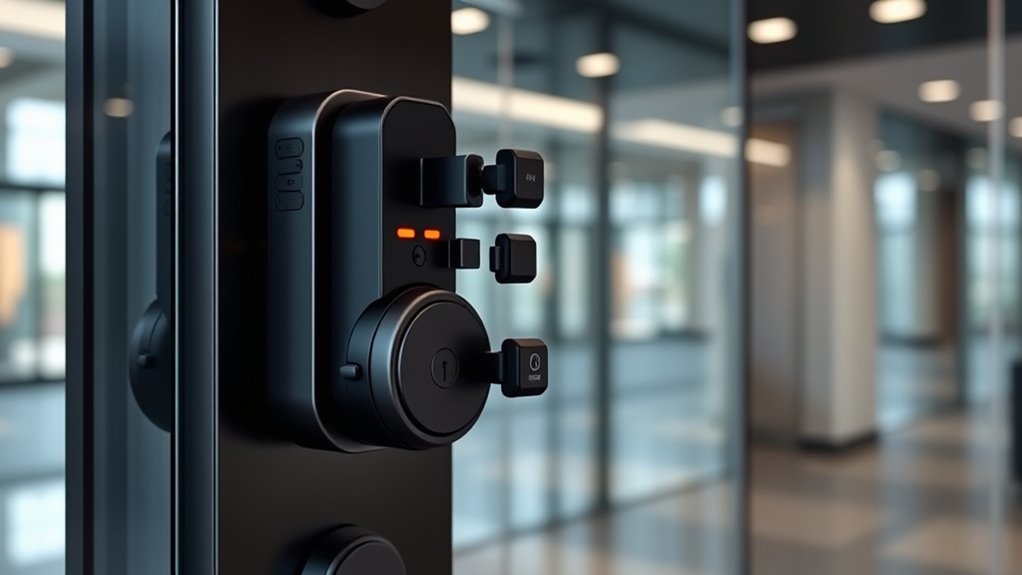
Several companies have successfully implemented modular smart lock solutions that demonstrate the potential of flexible, future-proof designs. These case studies showcase innovative features such as:
- Seamless wireless integration, allowing easy updates and expanded connectivity.
- Customizable aesthetics, enabling users to match locks with their decor.
- Upgradable modules, ensuring compatibility with new technologies without replacing the entire lock.
- Enhanced security protocols, adaptable through simple hardware swaps.
- Incorporating active listening and empathy in customer feedback processes helps developers refine modular designs to better meet user needs.
Best Practices for Manufacturers and Consumers in Future-Proofing
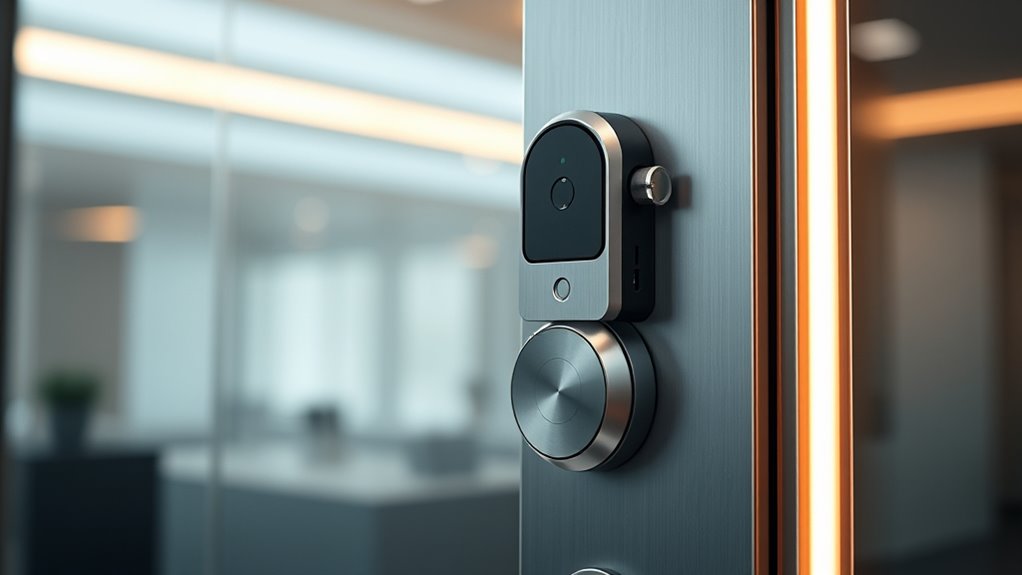
Building on successful modular smart lock implementations, manufacturers and consumers alike can adopt practices that extend the lifespan and adaptability of these devices. For manufacturers, prioritizing aesthetic integration guarantees that upgrades remain visually seamless, reducing the temptation to replace entire units. Incorporate energy-efficient components and protocols to minimize power consumption, which not only benefits the environment but also reduces long-term costs. Consumers should focus on maintaining modular parts and staying informed about firmware updates that enhance functionality. Both parties should choose compatible accessories and hardware that support future features. Regular assessments of your smart lock’s performance and compatibility help ensure it remains up-to-date. By emphasizing aesthetic integration and energy efficiency, you foster devices that are both durable and adaptable for years to come. Additionally, consulting expert advice and proven methods from reputable guides can further optimize the longevity and performance of your smart lock system.
Frequently Asked Questions
How Do Modular Smart Locks Impact Long-Term Security?
Modular smart locks enhance your long-term security by offering interchangeable security components, allowing you to update or replace parts as needed. This design provides clear upgrade pathways, ensuring your lock stays current with evolving technology and security standards. You can adapt your system without total replacement, reducing vulnerabilities. By choosing modular locks, you stay ahead of threats and extend your lock’s lifespan, keeping your home safer for years to come.
Are There Industry Standards for Modular Smart Lock Components?
You should know that industry standards for modular smart lock components are still evolving. Industry collaborations aim to establish common protocols, ensuring component interoperability and compatibility across brands. While some efforts exist, there’s no universal standard yet. This means you might encounter variations in how different smart lock modules work together. Staying informed about industry developments helps you choose modular systems that align with emerging standards, ensuring better future-proofing and security.
What Is the Average Lifespan of a Modular Smart Lock System?
You might wonder about the average lifespan of a modular smart lock system. Typically, it lasts around 5 to 10 years, depending on battery life and material durability. High-quality batteries guarantee longer use between replacements, while durable materials resist wear and tear. Regular maintenance can extend this lifespan. Keep an eye on component quality, as better materials and batteries directly impact how long your smart lock remains reliable and secure.
How Do Modular Locks Compare Cost-Wise to Traditional Smart Locks?
When comparing costs, modular locks often have a higher initial price but offer better long-term value. Their cost comparison with traditional smart locks shows they’re more affordable over time because you can upgrade parts instead of replacing the entire system. An affordability analysis reveals that modular locks save you money in the long run, especially as technology evolves, making them a smarter investment for your security needs.
Can Existing Smart Lock Users Upgrade to Modular Systems Easily?
Imagine you’ve installed a smart lock and want to upgrade. With retrofit compatibility, many modular systems let you do this easily, enhancing user upgradeability. For example, a homeowner can swap out outdated components for newer modules without replacing the entire lock. This flexibility simplifies upgrades, saves money, and extends your lock’s lifespan. So, yes, existing smart lock users can often upgrade effortlessly, thanks to modular hardware designed for easy user upgrades.
Conclusion
By choosing modular smart locks, you embrace flexibility, adaptability, and future readiness. You allow for easy upgrades, personalized features, and seamless expansion. You guarantee longevity, enhance security, and simplify maintenance. You stay ahead of technology trends, avoid obsolescence, and enjoy peace of mind. Embrace modular hardware today, and open a smarter, more resilient future for your home or business.
